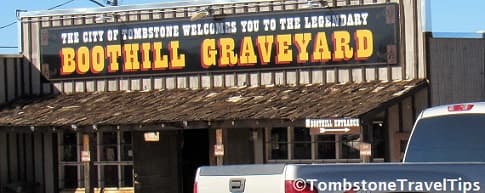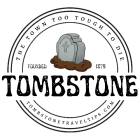Boothill Cemetery is definitely a must see when you visit Tombstone Arizona. Visitors to Tombstone Arizona may wonder if it is just a fake-out type of tourist attraction cemetery. Or if this famous Old West traditional burial ground is a real cemetery! Some people ask: Is anyone really buried in Boothill Cemetery?
Well – we can tell you!! Yes, it is the authentic cemetery from this old Wild West town! It is a real cemetery, and people are truly buried there! But it has seen some rough times in its history, and needed help to survive. So let’s go over its true story.

Yes, Boothill’s history is kind of crazy. Since we’d been locals in this historic town, we have been through Boothill cemetery a time or two! So we’d like to help you with Visiting Info>
And We’d like to let you know the inside info – not only what you’ll see today. But what we know, what we’ve discovered about this interesting attraction. How it had to have help to survive! How, as a cemetery, it needed to be resurrected from the dead!!

Boothill in 1880s Tombstone
This was not the first cemetery in the area. Two others preceded it. Good to know, to follow the way Boothill Cemetery came to be.
The First Cemetery1
The very first burial spot was more than a mile South of town. It was near the Grand Central mine, one of the original mines of the area. It wasn’t well cared for and mine tailings began to cover it over, blotting out the graves.
The Second Cemetery1
Around 1879 a more official burial ground was organized within reach of town. It took up an area the size of a city block. The boundaries compared currently from East to West: Sumner to First Streets. And then North & South from Bruce to Safford Streets. Looking at this area now, you’ll see it’s around the blocks where Family Dollar is located.
A Tombstone resident from 1880 to 1895 remembered this cemetery. George M. Swain described it having graves with fencing, and a Masonic section.
A new extension of this cemetery began toward the north. Although there was a vacant area without graves sitting between the two. When it expanded, the older cemetery area began to fall into disrepair. It was ultimately abandoned in preference to the Northern section.
Many years after its desertion, the land was looked to as property for construction. Homesites were divided within the block, and housing begun. The area’s history as a cemetery was refreshed when site excavations dug up skeletons and grave residuals.
Boothill – The Third Cemetery
When the second Tombstone area cemetery extended its reach northward, from beyond what now is E. Bruce St., the newer burial area was referred to as the “Old Cemetery.”
It was in use from about 1880, and about 3 to 4 years later had many grave-sites.1 The McLaury brothers and Billy Clanton were buried in the Old Cemetery after being shot dead at the OK Corral gunfight.

This “Old Cemetery” had specific sections – for instance by religion. The Catholic section kept growing larger and larger. They expanded on the West to accommodate those graves.1
Some have said it was also sectioned by nationality, but that may have been just a tribute that came later.4 This Jewish area can be found on the Northeast hillside. The Chinese area was at the very North end – a little beyond where today’s Boothill extends.1 When Mary Sing (China Mary) died in 1906, she was buried in the Chinese section. In January of 1938, Quong Kee also was interred there.2
The Tombstone population was growing. Homes were going up in the area. Buildings crept closer and closer to the Old Cemetery. The town government decided it should be closed, after organizing a new graveyard on the town’s Western outskirts. The Old Cemetery was officially closed on May 31, 1884.1
Sadly, after that, the entire area of this old graveyard was neglected over time. Residents forgot about the graves there, and their significance in history. People began using it as a garbage disposal area. No one called it by name anymore – the Old Cemetery. People referred to it as: that little cemetery on the road to St. David – only in reminiscence.3
The Fourth Cemetery
Becoming Today’s Town Cemetery
The City of Tombstone plotted out the New Cemetery on what was then called the Benson Road.1 Today, you’ll find this road is the Western extremity of Allen Street. It’s also the route to the Schieffelin Monument and grave-site.
The Tombstone Cemetery encompasses acreage on the South side of the road. James Lamb was the first to be buried there on June 30, 1884. Workers began relocating some graves from the Old Cemetery to this New Cemetery.1 But this burial ground also suffered through some sad times.
The City of Tombstone has had its difficult moments since this site opened. The Great Depression, population decreases, business closures all hit the town hard. During those times, funds for maintenance weren’t much forthcoming. A lot of grave markers were lost. There were about as many known in the cemetery as unknown.1
Today it is officially named “Tombstone Cemetery.” It’s open daily, with a large parking area. Some recognizable names are found here, including C.S. Fly.
The Boothill Resurrection
It all began with Frederick Bechdolt. Born in the East, he came West for college. He worked as a miner, driving Alaskan sled dogs, and as a laborer on the Cascade tunnel. He settled in California, writing, getting paid as an author.1 These travels and experiences influenced his fiction and nonfiction writings.

He wrote When the West Was Young – published in 1922.1 [You can see it, then Download This Free>] There’s a Western movie by the same name, but the story is different.
Anyway, Bechdolt visited Tombstone often enough, while researching that book in particular. And Western lore and history in general.
He walked the Old Cemetery on more than one of these occasions. He found it disturbing that this part of Old West history had not been preserved. He wasn’t even able to discern where specific burial sites were, who was even buried anywhere. The only one that was still obvious was a gravestone that named “Martin Peel.”1,4
He reacted in 1923 by writing to the Tombstone Epitaph, expressing disgust that the Old Cemetery was in such a state of dereliction. He noted his horror. He called out the City on how “the historical and practically only remaining ‘Boothill Cemetery’ in the West, was being kept.” This was the first time the Old Cemetery was referred to as Boothill.1
The Tombstone city fathers took note. Nobody in town had even considered that before. They sought Boy Scouts’ assistance for a clean-up in early 1925, ensuring no more garbage dumping at the site. But it was a battle.1
Despite a lot of local indifference, Bechdolt remained involved and concerned. He returned in May 1925 to address the Tombstone Luncheon Club. He spoke of preserving the history. He informed them it was just one of only three Boothill Cemeteries of the Old West still in existence.1
His talk finally triggered a nerve in some towns folk. A surveyor donated time to locate the boundaries, to be fenced. A fund was created for more clean-up and a planned restoration. The first official town mayor, John Clum, made the original donation – $10!1
People in Tombstone were getting excited about the opportunity for visitors to view this historic site. They stuck with the name “Boothill” as appropriate. The Luncheon Club placed signs so motorists could find their way.4
Another local man, Harry Macia, took charge of locating burial sites and restoring the gravestones. Upon finding that of the McLaurys and Billy Clanton, he placed the marker that stated “Murdered on the Streets of Tombstone.” And so the restorative work was somewhat underway by late 1925.4
Tourism was beginning to ramp up at the end of 1929. Tombstone AZ received a name for itself on the cross-continental route they called “The Broadway of America.” Boothill was a recommended stop.4 Thus a solid 12 day graveyard history revamping took place in December 1930. A few additional historic graves were found, and the McLaury/Clanton grave got a face-lift.3
The whole effort spurred talk about the historical preservation of the entire town. People talked, but the action for the rest of the town didn’t follow quickly.

Bechdolt’s book, and his articles for various publications, lent a world-wide interest in Tombstone Arizona, and its Wild West happenings. Many from outside the U.S. even sent letters to town with inquiries. They arrived with just an address of “Tombstone” – that was the notoriety it received!1
Boothill Today


Today you can visit the Boothill Cemetery, managed by the City of Tombstone. It’s on the way in to the town proper, on the East side of Hwy. 80. You’ll see the signs. Here are some visitor details you’ll want to know:
- Admission is $3 for those 16 years of age and up. Entrance fees support the city and its maintenance.
- Hours are daily from 8 am – 6:30 pm
- Phone number: (520) 457-3300
- The gift shop is managed by the Chamber of Commerce, a separate entity.
- It’s also an On/Off stop for those taking the Tombstone Trolley Tour

References
1 Bailey, L.R. (2004). Too tough to die: The rise, fall, and resurrection of a silver camp; 1878 to 1990. Westernlore Press, Tucson AZ.
2 Arizona Republic (1938, April 2). Tombstone sets Boothill service. P. 7. Phoenix AZ
3 Bisbee Daily Review (1917, Sept. 30). Tombstone’s old tombstones rich in fine romance. P. 5. Arizona.
4 Eppinga, J. (2010) Tombstone: Postcard history series. Charleston, SC. Arcadia Publishing.

Boothill hasn’t been run by the Chamber for the last 3 years. It is currently run by the City of Tombstone. 😉
The image that has an arrow pointing to the “Schieffelin Monument copy” isn’t a copy of Schieffelin Monument at all. It’s a monument to Tombstone pioneers 😉